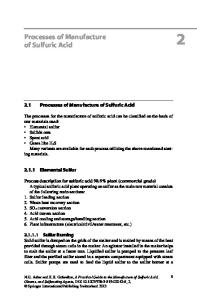Thermodynamic and Kinetic Studies of Dissolution of Hematite in Mixtures of Oxalic and Sulfuric Acid
- PDF / 977,195 Bytes
- 12 Pages / 595.276 x 790.866 pts Page_size
- 39 Downloads / 383 Views
Thermodynamic and Kinetic Studies of Dissolution of Hematite in Mixtures of Oxalic and Sulfuric Acid Paula Vehmaanperä 1
&
Riina Salmimies 1 & Antti Häkkinen 1
Received: 12 June 2020 / Accepted: 11 September 2020 # The Author(s) 2020
Abstract The dissolution of iron oxides in mixtures of acids is fairly uncommon but can result in a more efficient dissolution process. The objective in this work was to investigate the dissolution of synthetic hematite powder in mixtures of oxalic and sulfuric acid. Experiments were done at different acid ratios and temperatures. An increase in temperature from 15 to 35 °C increased solubility, whereas an increase from 35 to 50 °C did not change the solubility but had a profound effect on the kinetics. An important finding was that oxalic acid advanced the dissolution process since increasing the amount of oxalic acid in the system resulted in faster kinetics and higher solubilities. The dissolution kinetics were well described with the Kabai model, which was the only studied model able to describe the whole reaction time. However, the solid specific constant a varied for the different acid ratios and this is argued to be a result of changes in the solid phase. The changes in the constant a were not in line with the original study of Kabai, which indicates that a cannot be the solid specific constant but it can be the constant connected to dissolving media describing the changes in the dissolution mechanism. Keywords Dissolution . Hematite . Oxalic acid . Sulfuric acid . Kinetic modeling
1 Introduction Better understanding of the mechanisms and kinetics of dissolution can benefit several important industrial processes. For example, exploitation of dissolution phenomena can be utilized in the leaching of iron from clays, which are often used as a raw material in different processes. Moreover, the studies of Salmimies et al. [1] and Smith et al. [2] have shown that ceramic filter media, which are used in iron ore processes, can be successfully regenerated by acidic dissolution. A further study by Salmimies et al. [3] showed that oxalic acid is a significantly better acid for magnetite dissolution than commonly used sulfuric and nitric acids, primarily because of two possible dissolution mechanisms in oxalic acid: complexation and reduction. However, the use of oxalic acid in full-scale processes can be problematic. Firstly, preparation of the acid solution can cause dusting, due to oxalic acid commonly being used in the form of a solid dihydrate powder. Secondly,
* Paula Vehmaanperä [email protected] 1
LUT School of Engineering Science, LUT University, P.O. Box 20, FI-53851 Lappeenranta, Finland
oxalic acid is a costly chemical compared with sulfuric or nitric acid. Furthermore, the use of oxalic acid in process systems containing high quantities of calcium and magnesium can cause unwanted precipitation of oxalate forming salts with very low solubility. The dissolution mechanisms, kinetics, and thermodynamics of iron oxides have been extensively studied by numerous author
Data Loading...











